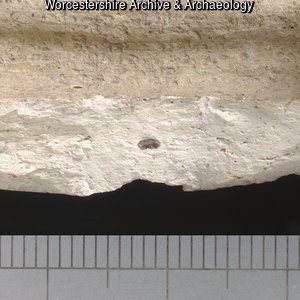Fabric 32 - Mancetter-Hartshill mortarium
Generally hard fabric containing sparse, well-sorted inclusions of sub-rounded and rounded quartz (<2.0mm), red and black iron-rich grains (<1.0mm) and pale coloured clay pellets. In the period before c.AD140, trituration grit consisted of ill-sorted angular and sub-rounded fragments of quartz, sandstone, red sandstone and some dark grains. After the mid 2nd century, they consisted almost entirely of fine-grained black and dark red argillaceous inclusions (Tomber and Dore 1998, 188-189).
Creamy white, sometimes with a pink core.
Creamy white, sometimes with a pink core.
Manufacture
Wheel-thrown
Decoration
Some examples have a thin yellow slip on the outer surface.
No source kiln defined
Distribution of this mortaria type was extensive in both the midlands and the north between the mid 2nd and early 4th centuries (Tyers 1996, 123; Bidwell 1985, 183). From the 2nd century, the market for mortaria in the midlands was dominated by products of the Mancetter-Hartshill and Oxfordshire (Fabric 33) industries. Sherds of this ware are found on sites throughout the Worcestershire region, although they generally represent a very small percentage of the ceramic assemblage as a whole (Buteux 1996, table 6).
1 related kiln
Distribution of this mortaria type was extensive in both the midlands and the north between the mid 2nd and early 4th centuries (Tyers 1996, 123; Bidwell 1985, 183). From the 2nd century, the market for mortaria in the midlands was dominated by products of the Mancetter-Hartshill and Oxfordshire (Fabric 33) industries. Sherds of this ware are found on sites throughout the Worcestershire region, although they generally represent a very small percentage of the ceramic assemblage as a whole (Buteux 1996, table 6).
1 related kiln
Roman (2nd to 4th century)
Mortaria of this type were produced from c.100AD to the later 4th century.
Mortaria of this type were produced from c.100AD to the later 4th century.
Hardness
Hard
Feel
Smooth
Fracture
Finely irregular
Surface treatment
Occasional thin yellow slip on external surface
Core colour
Pink
Int surface colour
Creamy white
Ext surface colour
Creamy white
| DB ID | Modified | Description | Frequency | Size | Sorting | Rounding |
|---|---|---|---|---|---|---|
| 165 | 0 | Quartz | Sparse | Coarse | Well-sorted | Rounded - sub-rounded |
| 166 | 0 | Grog | Sparse | Well-sorted | Sub-rounded | |
| 167 | 0 | Iron-rich pellets | Rare | Medium | Ill-sorted | Sub-rounded |
